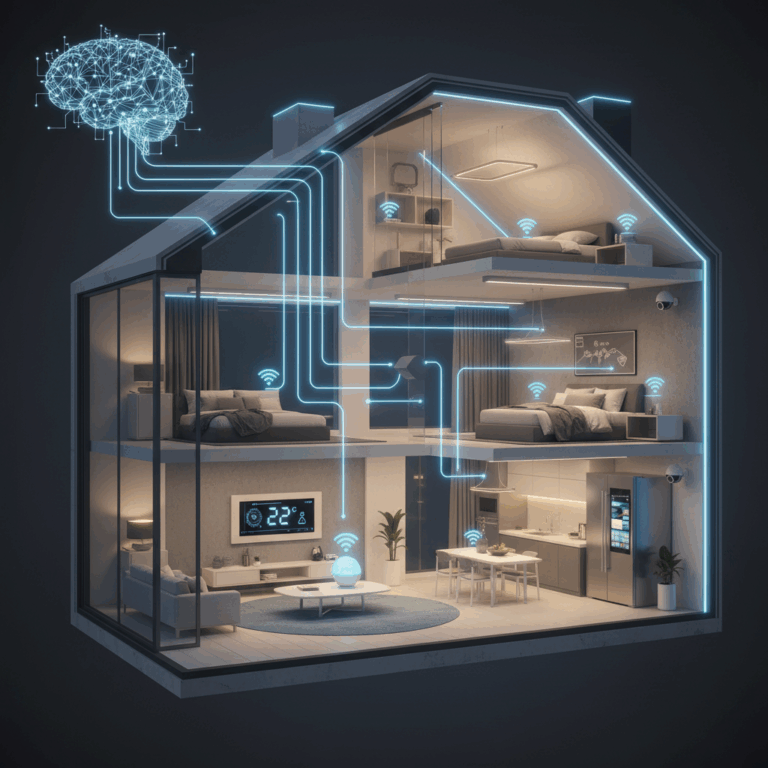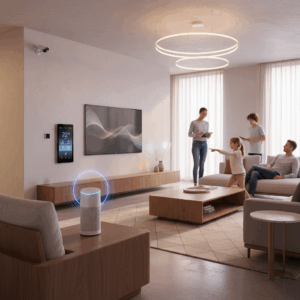Core Technologies in AI-Powered Smart Homes
AI-powered smart homes leverage advanced technologies to create intelligent environments that learn and adapt. These core technologies enable automation with minimal manual input, enhancing daily life.
The driving forces behind these innovations include machine learning and natural language processing. Together, they empower devices to understand patterns, predict needs, and interact naturally with users.
Machine Learning and Predictive Analytics
Machine learning helps smart devices recognize user habits and environmental changes. By analyzing data over time, devices optimize functions like temperature control and security monitoring automatically.
Predictive analytics extends these capabilities by forecasting future events based on past patterns. It enables proactive adjustments, reducing energy waste and enhancing safety within the home.
This combination allows smart homes to operate efficiently and responsively, creating personalized experiences that boost comfort and convenience without ongoing user management.
Natural Language Processing in Voice Assistants
Natural language processing (NLP) enables voice assistants to understand and respond to conversational commands. This technology makes interacting with smart devices intuitive and hands-free.
Voice assistants process complex requests, manage schedules, and control multiple smart home functions through natural speech, simplifying user engagement with technology.
By continuously learning from interactions, NLP improves command accuracy and responsiveness, fostering a seamless communication channel between humans and their smart environments.
Key AI-Enabled Smart Home Devices
AI-enabled devices are transforming homes into intelligent spaces that adapt and automate daily functions. These devices enhance security, comfort, and energy efficiency through advanced learning capabilities.
By integrating AI, smart home devices such as security cameras, thermostats, and voice assistants offer improved performance and user convenience. They work seamlessly to create a connected living environment.
These innovations reduce manual control needs, relying instead on adaptive behavior and predictive insights to optimize home management for modern lifestyles.
AI-Enhanced Security Cameras
AI-enhanced security cameras use sophisticated algorithms to detect motion, recognize people, and differentiate between pets and strangers. This reduces false alarms and improves home security accuracy.
Devices like the Aqara Camera Hub G5 Pro offer real-time alerts and integrate with automation hubs, becoming essential layers in a home’s security strategy. They support facial recognition for access control.
Continuous learning allows these cameras to adapt to changing environments, providing reliable monitoring and enhancing user peace of mind with proactive threat detection.
Smart Thermostats with Adaptive Control
Smart thermostats apply AI to learn household routines and climate preferences. They adjust heating and cooling schedules automatically, maintaining comfort while lowering energy consumption.
By incorporating weather forecasts and occupancy data, these thermostats proactively modify settings to optimize efficiency, potentially reducing utility bills by up to 15% annually.
Models like the Ecobee Smart Thermostat Premium adapt in real-time, balancing user comfort with sustainability by minimizing unnecessary energy use intelligently.
Voice-Activated AI Assistants
Voice-activated AI assistants enable natural language control over smart home devices, allowing users to manage lighting, appliances, and security hands-free with simple speech commands.
Assistants such as Amazon Alexa Plus and Google Gemini for Home extend functionality beyond device control by managing schedules, providing contextual information, and learning user preferences.
These interfaces enhance the user experience by offering intuitive, conversational interactions that streamline home automation and foster a highly responsive living environment.
Advanced AI Applications for Home Automation
Advanced AI applications are revolutionizing home automation by enabling predictive maintenance and dynamic energy management. These applications help optimize device performance and reduce costs.
By continuously monitoring appliance health and usage patterns, AI anticipates issues before failures occur, minimizing downtime and maintenance expenses through early interventions.
Predictive Maintenance and Energy Management
Predictive maintenance uses AI algorithms to analyze the operational data of household appliances, identifying signs of wear or malfunction early. This proactive approach prevents unexpected breakdowns.
Energy management systems employ AI to adjust lighting, heating, and appliance activity based on real-time occupancy and user behavior. This reduces energy waste and lowers utility bills efficiently.
Combining both, these AI-powered systems enhance home reliability and sustainability by ensuring devices run optimally and consume energy intelligently, adapting to daily routines and environmental factors.
Benefits and Future Impact of AI in Smart Homes
AI integration in smart homes significantly enhances convenience, security, and energy efficiency. Automation reduces manual effort while increasing responsiveness to occupants’ needs.
These smart systems create an adaptive environment that learns from user behavior, improving comfort and safety continuously. They also enable smarter energy use, contributing to sustainability.
Improved Convenience, Security, and Energy Efficiency
AI-powered smart homes automate routine tasks, freeing users from manual controls. Voice commands and predictive adjustments allow effortless management of lighting, climate, and security.
Security is strengthened through AI’s ability to recognize faces and detect unusual activity, minimizing false alarms and increasing safety with real-time responses. This promotes peace of mind.
Energy efficiency is optimized using predictive analytics that adjust heating, cooling, and lighting based on occupancy patterns, reducing wastage and lowering utility costs effectively.
Scalable Integration and Future Trends
AI-powered smart home platforms enable scalable integration of multiple devices, facilitating seamless communication and unified control across ecosystems. This ensures future upgrades are easily adopted.
Emerging trends include enhanced AI algorithms for more personalized experiences, deeper biometric security, and broader interoperability between manufacturers, driving smart home evolution.
Interesting Insight: AI and the Internet of Things (IoT)
The fusion of AI with IoT technology will enable homes to become even smarter by connecting diverse devices. This synergy allows for predictive maintenance and proactive problem-solving.
As AI continues advancing, smart homes will not only react but anticipate needs, transforming ordinary living spaces into highly efficient, self-managing ecosystems.






